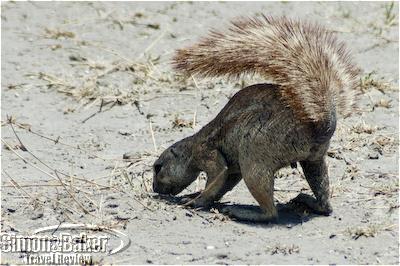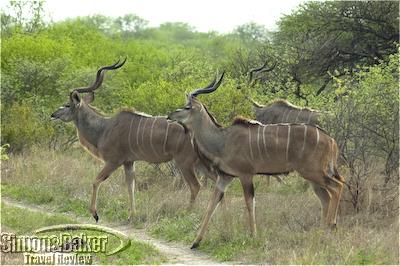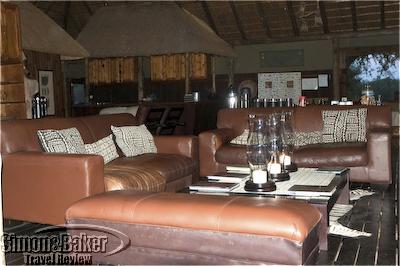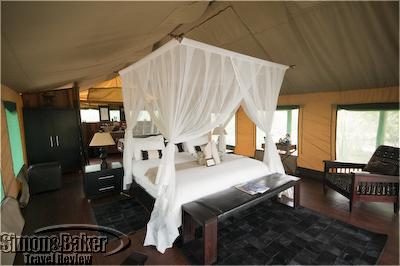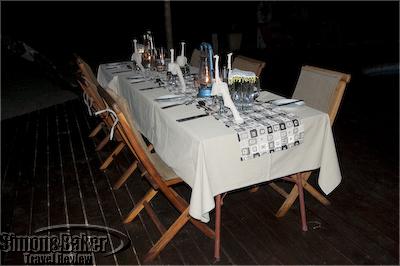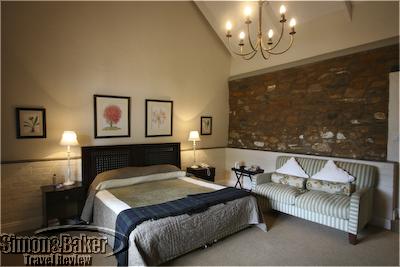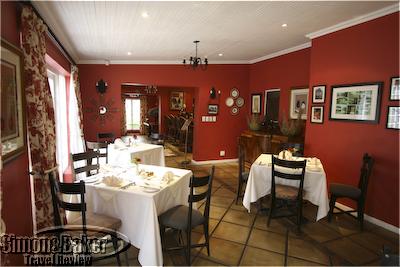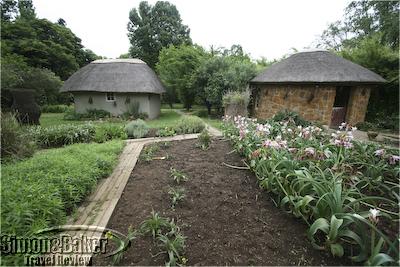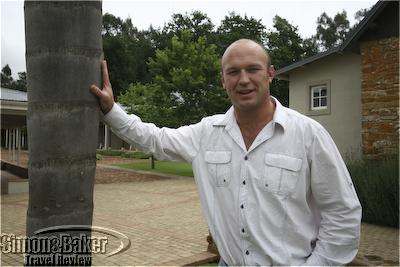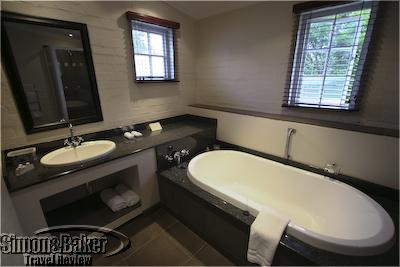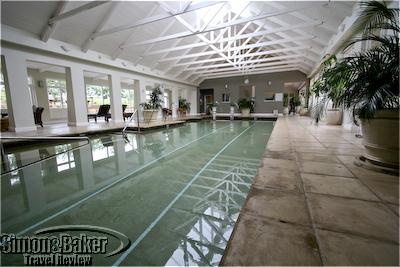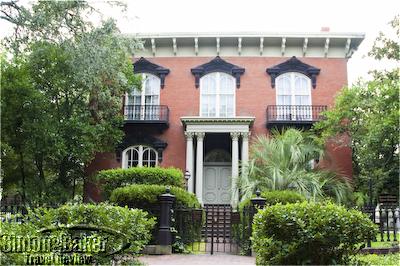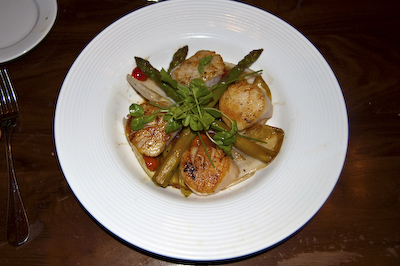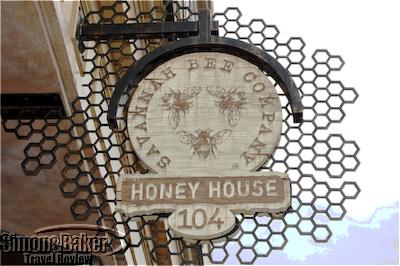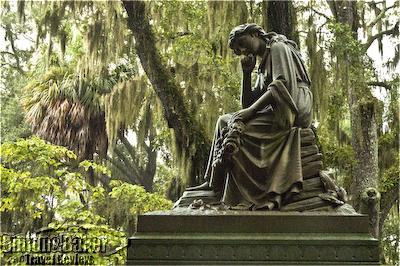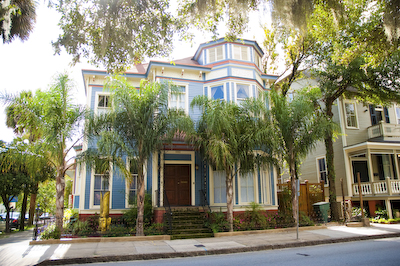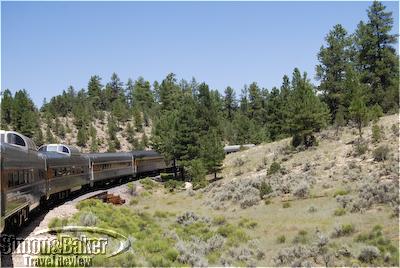by Editor | Jul 23, 2010 | Luxury Travel
The International Ecotourism Society (TIES) launched the annual Innovation Leadership in Sustainable Tourism Awards to recognize individuals and organizations who demonstrate leadership in innovative actions that promote sustainable tourism and bring tangible benefits to communities and conservation. The Award winners, one individual and one organization, will be honored for their best practices and innovative actions, based on one example of an innovative project, product, or program developed in the previous year that supports the goal of uniting communities, conservation, and sustainable travel.
Award applicants need not be members of TIES. Submissions will be judged by the organization’s Advisory Board based on one example of an innovative project, product, or program developed in the previous year that advocates for uniting communities, conservation, and sustainable travel.
Applications must be submitted online by August 2, 2010. Finalists will be announced by August 6, 2010. The top ten finalists’ submissions (five individuals and five organizations) will be posted on Your Travel Choice Blog from August 6, 2010 to August 20, 2010. Project stakeholders, supporters and TIES members will be encouraged to comment on finalist submissions. The advisory board will take testimonial comments in making the final selections August 25th, 2010.
The winning two finalists will be honored at the Ecotourism and Sustainable Tourism Conference 2010 (ESTC 2010), receive one free registration to ESTC 2011 and be recognized through TIES website, ESTC website and e-newsletters. More information on TIES Innovation Awards and nomination instructions are available at: www.ecotourism.org/innovation-awards.
by Editor | Jun 14, 2010 | Accomodations, Ecotourism, Luxury Travel, New Articles
Photos by Gary Cox
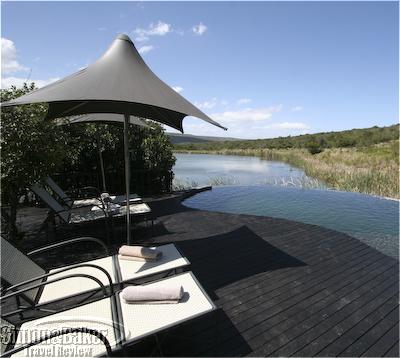
The Kichaka pool and water hole
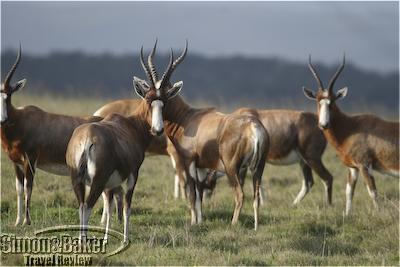
There were two daily game drives at Kichaka
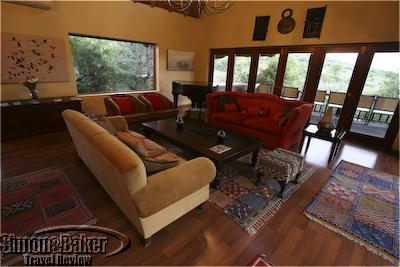
A common area at Kichaka
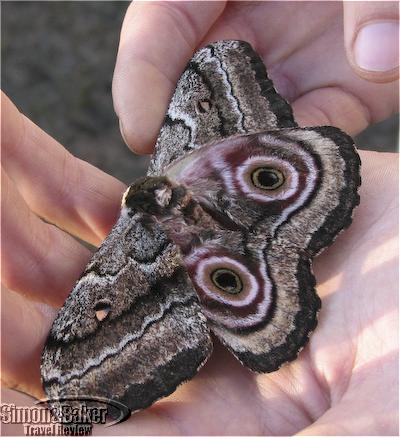
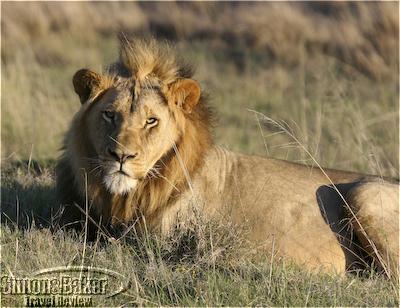
There was game viewing of the small and large varieties at the lodge
Kichaka, an Eastern Cape, South Africa luxury game viewing lodge with 10 suites, offered visitors to the region excellent meals, luxurious suites with lots of privacy and twice daily game drives. Elena and Gary thought it was a great place for a romantic getaway and for visitors to South Africa’s Wine Route wishing to get a taste of game viewing in a luxury environment. Click here to read our team’s detailed article about the Kichaka Luxury Game Lodge.
by Editor | Mar 15, 2010 | Luxury Travel
Article and photos by Josette King
A Kalahari squirrel uses its tail for shade
Male kudus emerge from the bush
In the mainly roadless wilderness of the Kalahari Desert (“thirstland” in local Setswana language) that covers roughly two-thirds of Botswana, adventure usually begins with a bush plane flight into the middle of nowhere. On this particular day, the flight was taking me on a southeastern heading from the Makgadikgadi Salt Pans toward the Central Kalahari Game Reserve, a semi-arid immensity the size of Switzerland located in the center of the country. After one soporific hour in the steamy cockpit, gazing at some of the flattest, emptiest landscape I had ever seen, I did a double take. We were starting our descent toward a green-forested expanse neatly slashed by a long airstrip. Wasn’t the center of the Kalahari to be the most barren destination of my entire itinerary? It would be, but that was an adventure for another day.
For now, I had arrived at Haina Kalahari Lodge, an intimate luxury retreat nestled in a private conservancy abutting the northern border of the game reserve. An unexpected heavy rainstorm the previous week had injected exuberant life into the land. The trees were bursting with green buds and the trumpet thorn bushes were filled with the white and purple flowers that gave them their name. Impalas, kudus, oryx and and steenboks feasted on new grass, and big cats feasted on antelope. Giraffes kept at a cautious distance from the fray. The conservancy was home to a resident pride of large, vocal Kalahari lions, the males with their distinctive black-tipped mane. Most game drives produced at least one lion sighting. Cheetahs were stealthier, allowing me only an occasional glimpse.
The lounge
My luxury tent at Haina
The al fresco dining area
The lodge was a haven of contemporary luxury and casual atmosphere, graced with the some of the latest in modern conveniences, such as reliable satellite WiFi Internet connection in the main lodge and solar-generated electricity throughout the property. The superbly appointed oversized guest tents were sited for total privacy, making all the more enjoyable their large, front veranda and rear glass enclosed indoor showers overlooking the bush. With this winning combination of creature comforts and nearby game, I was fleetingly tempted to remain within the conservancy for the duration of my stay at Haina.
But the harsh wilderness of the Central Kalahari Game Park was only a drive away, especially Deception Valley, where a river had meandered some 16,000 years ago. More recently, it had been the site of the camp were American Zoologists Mark and Delia Owen had lived in tents for seven years in the 1970’s while conducting research on Kalahari lions and brown hyenas. For me, it became the destination of a fascinating day-long drive in a landscape punctuated by distant mirages, birds silently gliding on the faintest of hot air updrafts, and the occasional antelope standing stock-still under the sliver of shade from a desiccated tree. Click here to read more about my visit at Haina Kalahari Lodge.
by Editor | Feb 1, 2010 | Luxury Travel
Article by Elena del Valle and photos by Juan Cooper
Room 6 at Fordoun Hotel and Spa
The dining room
We liked the Fordoun Hotel and Spa, a family owned and managed boutique hotel and spa established in 2005 in South Africa’s KwaZulu Natal area, for its intimate size, friendly staff, gourmet oriented restaurant, and diverse fitness and spa facilities and treatments including African themed options. The family friendly hotel, built within a working 275 hectare dairy farm, was named after a loch in Scotland.
During our overnight stay at Fordoun we had an opportunity to sample the cuisine at Skye, the hotel’s restaurant named for the Isle of Skye in Scotland. Breakfast was a combination of buffet and a la carte offerings. At lunch there were light dishes and hearty fare and we had a fun visit from a handsome peacock and peahen pair with full plumage on display. Our favorite meal was dinner. After we had our aperitifs in a nearby fire lit lounge and we moved to the dining room for a tasty meal. We remember the Wild Dagga smoked kudu with hummus and pita bread and reedbuck with cabbage and mashed potatoes courses most. We especially enjoyed the chance to chat with Richard Bates, general manager of the hotel and spa.
Herbs from the Fordoun herb garden were used in the Fordoun spa and Skye restaurant
Richard Bates
From him we learned of the owners’ environmental, cultural and social responsibility programs. One of these is the donation of 150 hectares of their land to the KwaZuluNatal Crane Foundation to serve as a breeding habitat for wattled crane and oribi Antelope, two highly endangered species, in what is now the Bill Barnes Crane and Oribi Sanctuary. Other noteworthy efforts are the support of the community school through donations and infrastructure improvements; the use of solar power for the hotel and spa facilities; the incorporation of Zulu healing methodologies in the spa menu as well as the development of a greenhouse and herbal garden where staff grow and research 130 indigenous healing plants for suitability as crops for teas, cosmetics, culinary or medicinal uses.
The five star hotel and spa were built within the original 1860s settler homestead and barns and the 1950s dairy, manager’s house, garages and cattle sheds; and designed in a contemporary style to retain some of the history of the estate. Our rooms, 6 and 10, were 96 and 98 square meters in size respectively, each with a distinctive decorative style.
The bathroom in Room 10 at Fordoun Hotel and Spa
Room 10 at Fordoun Hotel and Spa
Room 10, my room, was Africa themed with earth colors and a cow hide bench at the foot of the bed. African artwork and sand colored curtains hung on the walls. The floor was covered with wall to wall carpeting. A high white ceiling and stone walls added a sense of spaciousness of the room. A comfortable king bed framed by identical wood night tables with lamps occupied the center of the room which was also furnished with two striped armchairs, small air conditioning unit, two-seat sofa and corner cabinet with a Tedelez television at the top and a minibar with mini refrigerator and snacks on the lower level. The bathroom had a glass enclosed extra large shower and a separate bathtub. Our rooms were serviced twice daily.
The swimming pool was in the spa building
Fordoun Hotel & Spa (PO Box 17 Nottingham Road 3280, KwaZulu Natal, South Africa, +27 033 266 6217 and + 27 033 266 6630, www.fordoun.com and info@fordoun.com). Click here to read about our visit to the Fordoun Spa.
by Editor | Jan 11, 2010 | Luxury Travel, Restaurants
Article and photos by Josette King
Victorian gems are being restored to their original charm
It is said in Savannah that when its founder General James Oglethorpe departed for England in 1743 he left instructions not to change anything until he returned. He never did. And although the city expanded in the centuries that followed, it retained the grid pattern of verdant squares linked by broad avenues envisioned by Oglethorpe. Today, under its iconic canopy of ancient live oaks fluttering with Spanish moss, Savannah remains a languid antebellum city of elegant colonial mansions and Southern charm.
But while history resonates at every turn, so does the creative energy of the city’s art scene stimulated by the students, faculty and alumni of the booming Savannah College of Art and Design (SCAD). Their inspiration is very much in evidence at the college’s own store, shopSCAD (300 Bull Street). This unique emporium is bursting with cutting-edge paintings, photographs, pottery, jewelry and wearable items; reasonably priced creations of the students, faculty and alumni of the college.
Historic colonial homes line the squares of Savannah
Creativity spills over into other areas of the city’s life as well. Young chefs put their own original spin on Southern classics and old favorites from around the world that have settled over time in the historic port city of Savannah. I enjoyed several lovely meals during my recent visit, most notably a dinner at Local 11ten (1110 Bull Street). Since he took over the kitchen in early 2008, Chef Jeff Rodgers has worked closely with a handful of trusted small suppliers to source the best locally grown and harvested products he showcases in his refined yet unpretentious menu.
Scallops seared to perfection at Local 11ten
And word has been spreading that something wonderful is happening at Local 11ten. A friend who had recently visited Savannah recommended it, “and make sure to try the scallops,” he said. I did. The four gigantic sea scallops were so fresh and sweet they required only the slightest bit of searing. They were served on a bed of crisp asparagus and barely wilted endive, drizzled with a warm sweet pepper vinaigrette, their tartness the perfect foil for the sweetness of the scallops. But equally palate-thrilling were the amuse-bouche: a generously-sized lobster cake served with a glaze of horseradish and sherry sauce. We unanimously declared it worthy to become one of Chef Rodgers’ signature dishes.
The Honey House, a favorite stop for discriminating foodies
For creativity in retailing, my personal award goes to the Honey House (104 Broughton Street). Opened in 2008 as the flagship store of a local artisanal honey producer, the Savannah Bee Company, this Historic District storefront has already established itself as a required stop for local and visiting gourmets and other discriminating shoppers. The shop was a visual feast, brimming with artfully arranged displays of all things honey. The company’s signature tapered bottles lined the walls, filled in many shades of gold, from deep sourwood to rich tupelo to pale acacia honey and several hues in between.
The Bonaventure Cemetery is famous for its elaborate monuments
The stacks of body-care offerings were equally irresistible, from Royal Jelly body butter to bees wax and nail salve and mint julep lip balm. Deeper into the store a floor to ceiling hive playroom invited children to pretend they were bees, while adults browsed the tempting array of bee themed toys and children’s clothing. Bee-keeping jumpsuits, hats and other paraphernalia were also available. Feeling weak from so many choices, I repaired to the bar for a honey cappuccino and honey tasting (the full-bodied Tupelo honey was my favorite), but for me the ultimate indulgence was the honeycomb sampling tray. Who would have thought a sliver of honeycomb on a slice of sharp cheese, or tart green apple, could taste to wonderful?
The Waldburg, a charming Queen Anne home overlooking the park
Meanwhile, there is also much happening on the architectural preservation front, which is gaining momentum around Forsyth Park, Savannah’s Central Park at the southern edge of the Historic District. This is the Victorian District where graceful 19th Century houses overlooked for decades are now being painstakingly brought back to their original loveliness. I had the pleasure to stay in one of them during my visit to Savannah: The Waldburg, a charming Queen Anne house overlooking the park.
It was recently the object of a thoughtful renovation into two elegant vacation apartments, clearly with the comfort and enjoyment of their guests in mind. Conveniently located within walking distance from many of the most sought-after tourist attractions in Savannah, it was an ideal base from where to experience the gracious essence of this most Southern of cities. Click here to read more about my recent visit to Savannah, and my most enjoyable stay at The Waldburg.
by Editor | Dec 14, 2009 | Luxury Travel
Article by Elena del Valle and photos by Amparo Cadavid
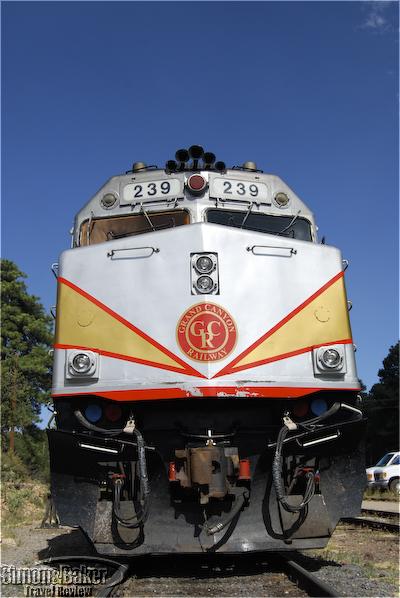
Grand Canyon Railway
Although Sedona had plenty of worthy attractions and we were enjoying the local sites, the allure of the Grand Canyon was irresistible so we dedicated one day of our week long visit to Sedona to that majestic area. Instead of making the round trip drive from Sedona to the Canyon’s South Rim at an elevation of 7,000 feet, we chose to ride the Grand Canyon Railway (233 N. Grand Canyon Blvd, Williams, Arizona 86035; www.thetrain.com, info@thetrain.com,1-800-THE-TRAIN). The train departed from the small town of Williams, about one hour drive north of Sedona.
We set out about 7:30 a.m. down a pretty canyon road from Sedona to meet up with the highway (Interstate 17) that led us to Williams; and returned to Sedona at 7 p.m. just in time for dinner. Parking was easy once we found the train station and we boarded the train on time for the daily 9:30 a.m. departure. The train, pulled by a diesel engine, traveled at 40 miles per hour over 65 miles and could accommodate up to 700 passengers in nine cars offering varying degrees of comfort.
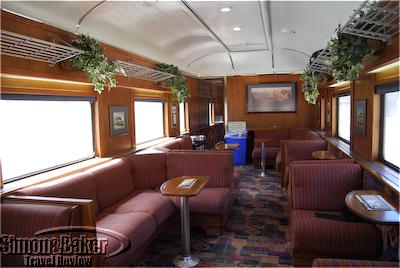
Grand Canyon Railway Luxury Parlor Car
Our Luxury Parlor Car, Chief, was the last and most luxurious on the train and to our delight it was only half full on the midweek August day we traveled, allowing us to spread out comfortably. There was a wood bar and a spacious water closet in the middle of the car. At the back, there was an open air platform for up to six people at a time to enjoy the outdoor sights and sounds. The platform was our favorite part of the train.
Our car was manned by Attendant Katie McKinnon and Christine, a trainee. They kept us informed, opened the complimentary small buffet (mini muffins, fruit salad, yogurt and apples) and served drinks including complimentary coffee (and champagne on our return). On the way there, we were assigned seats 21D and 23D at the back of the car. The two-and-a-half hour train ride passed quickly and soon we arrived at the Grand Canyon where we had three hours to explore on foot, take a bus tour or have lunch. While it was possible to have a sit down lunch at one of the local restaurants we were there to see the Grand Canyon and since we had limited time we preferred to explore the sites.
We chose to walk along the paved hiking path, following Katie’s recommendations, and have a quick bite at the cafeteria before returning to the train for our ride home. Since we were returning to Williams that same day we were invited to leave any belonging we didn’t require for our visit to the park on board our train car. This was very convenient since it was the middle of a hot summer day and we planned to walk for the better part of three hours.
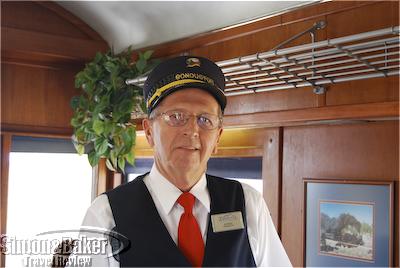
Our train conductor

A train "robbery"
Before boarding there was a “shoot out” which we missed due to a slight delay finding our way to the station. On the way back the train was “held up” by “robbers.” Also, Craig Summers, a native of Jacksonville, Florida played his guitar and sang country songs during the train ride, moving from car to car along the way. The Grand Canyon Railway, now owned by Xanterra Parks and Resorts, began operations in 1901.
Our day trip to the Grand Canyon South Rim was entertaining and relaxing at the same time. Making the round trip trek on Grand Canyon Railway rather than driving was the perfect solution to our time limitation and desire to visit the Grand Canyon for the day. The next time, maybe we’ll spend the night at the park and enjoy the sunrise and sunset or be adventurous and journey to the depths of the Canyon on mules.






